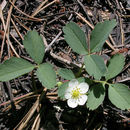Brief Summary
(
англиски
)
добавил EOL authors
Fragaria virginiana, Virginia strawberry (also known as mountain or wild strawberry), is a low-growing herbaceous perennial in the Rosaceae (rose family) native north temperate regions of North America, where it is wildly distributed from Newfoundland west to Alberta, and southward to Georgia, Tennessee, and Oklahoma, as well as in the Klamath, Cascade, and Sierra Nevada mountain ranges. The fruits are often collected in the wild, and this species is one of the progenitors (along with F. chiloensis) of the hybrid F.X ananassa, the garden or pineapple strawberry, which produces the bulk of commercially harvested strawberries. F. virginiana plants are characterized by basal rosette of compound leaves, 2.5 to 10 cm (1 to 4 in) long, with 3 leaflets, each having 4 to 8 pairs of teeth. The plants are characterized by long arching runners or stolons, and that allow them to reproduce vegetatively as well as by seed. The small, white, 5-parted flowers, 0.5 to 2.5 cm (0.25 to 1 in) across, occur in small clusters. The strawberries are quite small, 0.5 to 2 cm (0.25 to 0.75 in) across, and generally ripen to red. The strawberry is not a true berry, but is a fleshy receptable bearing multiple fruits on the surface—these apparent seeds are actually achenes, small, one-seeded fruits with hard coverings that do not split open (dehisce) when ripe. The achenes on F. virginiana occur in deep pits (as opposed to projecting from the surface, as in the related and often co-occuring F. vesca, woodland strawberry). Virginia strawberries are often wild-harvested, and sometimes cultivated. The small strawberries may be eaten fresh, cooked, or dried. They were important to indigenous people in the Great Lakes and Midwestern Prairie regions and Canada, who used the fruits for food, and prepared tea from the leaves. This species generally grows at altitudes between 1200 and 3300 m. It has a wide distribution in North America, and may grow in hardwood, conifer, and mixed forests, as well swamps (but not in the wettest parts), shores, and clearings. It may be found in drier and sunnier sites than F. vesca. (Bailey et al. 1976, Flora of China 2012, Michigan Flora Online 2011, USDA 2006, van Wyk 2005.)

